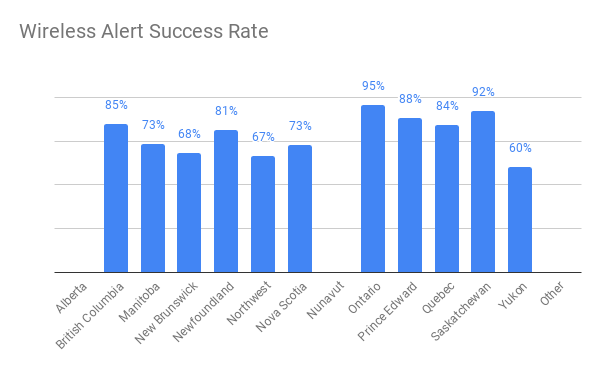On November 25, 2020, provincial and territorial emergency officials across Canada, with the exception of Nunavut and Alberta, conducted tests of the Alert Ready system. These alerts were sent via radio, television, LTE compatible wireless devices, and other third-party emergency alert distribution channels such as Alertable.

The one-way broadcast nature of most Alert Ready distribution channels such as radio, television, and LTE compatible wireless devices does not provide a direct way for the public to provide feedback on alerts received, including test alerts. Therefore, Public Emergency Alerting Services Inc (PEASI) took the initiative to solicit feedback for the November 25, 2020 test, with a specific interest in the effectiveness of the wireless alerting channel.
PEASI created an online survey and asked the Canadian public to complete it. The survey was widely shared via municipal officials, social media, news organizations, and on the Alert Ready website before and during the tests. In total there were 11,451 responses.
Survey responses came from:
- 36.9% – Quebec
- 33.7% – British Columbia
- 23.4% – Ontario
- 6% – combination of all the other Canadian provinces/territories
While Nunavut and Alberta did not participate in the test, survey responses were received from the public in these areas and this data was included in the report created.
Success of the test alert:
- 85.9% reported receiving the wireless test alert
- 14.1% reported not receiving the test alert
- An increase of 8.4% was reported in the success rate from the last test alert in November 2019

Success rate by province:
- Ontario-95%
- Saskatchewan-92%
- Prince Edward Island-88%
- British Columbia-85%
- Quebec-84%
- Newfoundland and Labrador-81%
- Manitoba-73%
- Nova Scotia-73%
- New Brunswick-68%
- Northwest Territories 67%
- Yukon-60%
One of the survey questions asked:
“if you could improve one thing about emergency alerts, what would it be?” And the top 5 responses included:
- Be able to override silent mode on phones;
- Have different sounds for different alerts;
- Alert information should be more clear and consistent (although 95.3% of respondents said the alert was clear and understandable, improvement is always possible) and improve the content and display (e.g. include pictures, video, language translation, etc.);
- Send the Test Alert as a text message. Some respondents didn’t know how to get back to the message once it had disappeared from the lock screen on their phones; and
- Make an app available to download for devices that are not compatible with the Alert Ready system.
Next to wireless alerts, the most popular distribution methods were television and third-party mobile apps. Radio and social media were also ways that the alert was received. 23% reported that this was their first alert and 23% reported receiving a real alert in the past as well as having received the most recent test alert.
For those with issues receiving the alert:
- 57.7% came from those with Android devices
- 41.8% were using Apple devices
- 42% reported having received a previous alert
- 41% of respondents were using Telus as their service provider, 21% were using bell and 14% were using Rogers
For those who have devices not compatible with the Alert Ready system, Alertable is a great option to ensure that you still receive emergency alerts. Alertable is able to send notifications more than 15 different ways allowing increased recipient choice and increased compatibility with systems like Alert Ready.
To read more about Alert Ready click here
To read the Alert Ready test survey report in its entirety click here
What are other tips we could talk about? Leave a comment below and let us know.
Read more on our Disaster Series:
To sign up for Alertable or to learn more visit https://alertable.ca
 .
. 